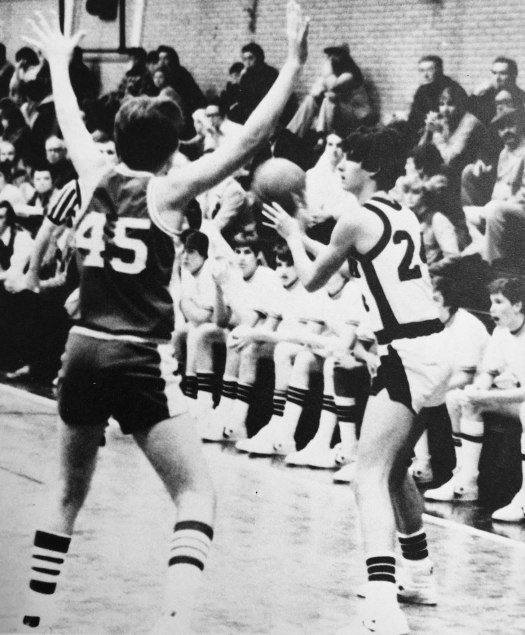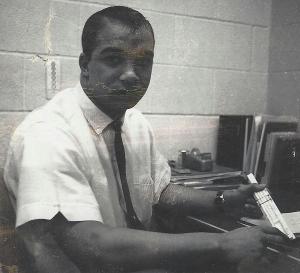28 years after earning dual degrees from MIT, a fellow Friar let present-day students glimpse his Jet Propulsion Lab work for NASA.
By Mark Vruno
When alumnus Dan Chang, PhD. ’85 returned to Fenwick last November, he felt right at home talking to students in the school library. Ever since immigrating to northeast Illinois from Taipei, Taiwan, in 1976, Dr. Chang has had an affinity for libraries and books.

Ten-year-old Chang spoke no English when he came to the United States. His father was a diplomat for the Taiwanese consulate in Chicago. During the summer, when their mother was working as a medical technician, his sister Anne and Dan went to the public library “almost every day,” he told the Forest Park Review eight years ago, “and I read every book about physics, space and aviation.” Before applying for a scholarship to Fenwick as an eighth grader, the future rocket scientist attended Grant-White, and then Field-Stevenson elementary schools.
“Let’s talk about the universe,” Chang engaged one group of science students last semester, as he booted up a customized PowerPoint presentation. Over the past four decades, there have been some rather astonishing developments as the field of astronomy became less Earth-centric, he told present-day Friars: “When I was in high school, we didn’t know there were other stars with planetary systems. Now, we know there are nearly 4,000 exoplanets!” (An exoplanet, or extrasolar planet, is a planet outside of our solar system.)

“Did you know there are more planets than stars in the galaxy?” Chang continued. “Small planets are common, even in the Habitable Zone, but they are too dim to see through a telescope,” he added. In astronomy and astrobiology, the circumstellar habitable zone (CHZ) is the range of orbits around a star within which a planetary surface can support liquid water given sufficient atmospheric pressure. Such complexity is par for the course for Chang, who was a straight-A student at Fenwick, a National Merit Scholar Finalist and one of three valedictorians from the Class of 1985. (Chris Hanlon and Ray Kotty are the other two.)
Chang went on to study at the prestigious Massachusetts Institute of Technology (MIT). He says he “held my own” at the private research university and earned a bachelor of science in aeronautics/ astronautics, then a master’s degree in dynamics/control. After moving to the West Coast to work for NASA’s Jet Propulsion Laboratory (JPL, see below), he would go on to a doctorate, in electrical engineering and photonics, from the University of California at Los Angeles (UCLA) in 2002.

In the aforementioned newspaper article, ’85 classmate Kotty, who has taught math at Fenwick since 1993-94, described his former Computer Club and “mathlete” teammate as “a little bit more [of] a risk-taker than the other guys in the math-club group. He was always going to go ahead and blaze his trail.” Outside of school, the two mathematical whizzes attended weekend astrophysics classes together at Chicago’s Adler Planetarium — and have remained friends over the years.
Chang told students in November, “For the record, Mr. Kotty beat me in just about every math competition at Fenwick!”
Demanding yet kind

As a high-school student, Chang never experienced faculty legend Roger Finnell ’59 (long-timeMath Department Chairman) in the classroom per se. Mr. Finnell was — and is — moderator of Fenwick’s storied Math Competition Club. Chang fondly remembers what he calls “rigorous” teachers, including Mr. Ramzi Farran (chemistry and JETS coach) and Mr. John Polka (biology), both recently retired, as well as the late Mr. Edward Ludwig (calculus) and Fr. Jordan McGrath, O.P. (pre-calc.), who passed away in 2018.

“They all were very kind but very demanding,” he remembers, adding that Ludwig and McGrath were not perceived as being kind, initially. “They seemed harsh at first. They pushed us,” explains Chang, who jokingly refers to Ludwig as the Fenwick’s “Director of Happiness.” Looking back, however, the former student appreciates these teachers’ collective toughness.
Other Fenwick teachers were as influential, if not more so, to Chang’s developing, teenage brain. “Math always was easy [for me] to do,” he admits. “It is a rich but one-dimensional subject. Large, open-ended subjects, such as history and literature, are different.” As a sophomore in 1982-83, he discovered cognitive enrichment in honors English with Fr. Dave Santoro, O.P., honors history class with Mr. John Quinn ’76 and speech class with Mr. Andrew Arellano. In those courses of study, “I learned how to think and debate. I developed political opinions. The strategic thinking and soft-skills I began to glimpse then are arguably as important to my job today as the technical, ‘hard-skills.’”
“The strategic thinking and soft-skills I began to glimpse then [at Fenwick] are arguably as important to my job today as the technical, ‘hard skills.’”
Dr. Dan Chang
Back to school

This past November, Chang explained to students the discovery of exoplanets by employing the so-called “stellar-wobble” method, as well as the transit photometry method. Doppler spectroscopy (also known as the radial-velocity method, or colloquially, the wobble method) is an indirect method for finding extrasolar planets and brown dwarfs from radial-velocity measurements via observation of Doppler shifts in the spectrum of the planet’s parent star; while the transit method essentially measures the “wink” of a star as an exoplanet passes before it. (The Nobel Prize in physics for 2019 was awarded partially for the first exoplanet discovery, employing the radial velocity method.)
Chang spent several years of his career on JPL’s Stellar Interferometry Mission (SIM), which was an attempt to discover exoplanets using yet another method – direct astrometry, but with unprecedented precision. SIM proved to be too much of a technological stretch and was cancelled in 2009. “The technology is very difficult,” Chang stressed, “measuring angle changes down to approximately 4 micro-arcseconds,” which is about a billionth of a degree. (An arcsecond is an angular measurement equal to 1/3600 of a degree.)
During his nearly 29-year career at JPL, Chang’s technical contributions and leadership have been recognized with numerous individual awards, including the NASA Honors Award in 2007. For the past three and a half years, he has been the project manager of JPL’s Program Office 760, which is known as the “Technology Demonstrations Office.” While details cannot be disclosed, he is responsible for the management and technical direction of the more than 100 people who work within the classified program. Chang, who reports to JPL’s Director for Astronomy and Physics, was Office 760’s chief engineer for two years prior to overseeing the program.
“This part of astrophysics is close to my heart, but let’s now look at an engineering tour de force,” he proclaimed to the young, fellow Friars, switching gears and delving into the basics of how the Mars landing system works.

$200 million to develop a propulsive, soft-landing system using a massive parachute for potential use on Mars. The helium balloon has a 110-foot diameter – a canopy big enough to fill the Rose Bowl football stadium in Pasadena, California!
“The United States still is the only country that has successfully landed vehicles on Mars (the massive Curiosity rover in 2012 being the most recent),” he informed the students. “We have been [remotely] driving around up there for seven years.” From 2004-07, Chang served as a principal investigator under the Mars Technology Program (MTP), for which he helped to develop LIDAR for lander terminal guidance.

With all the Martian craters and high-wind dust storms (up to 70 mph), “how do you safely land a probe?” he asked. JPL succeeded in 1997 with its toy-car sized Pathfinder robotic spacecraft, which employed the new (at the time) technology of airbag-mediated touchdown. JPL returned again in 2004 with MER, again using airbags and a crude, wind-compensating rocket system called DIMES. However, for the Mars Science Lab mission in 2012 that landed Curiosity – “essentially a nuclear-powered, 2,000-pound MINI Cooper – we had to resort to lowering the probe on a tether to solve the egress problem and other challenges.” This technology is NASA’s rocket-powered Sky Crane, developed for the Curiosity landing and will be used again when the Mars 2020 mission attempts its next landing. “It was surprising to us that it worked!” Chang remarked.

In less than 12 months, another robotic rover could be roaming and exploring the “Red Planet” in a quest to answer that age-old question: Are we alone in the universe? Scheduled for a July 17 launch, Mars 2020 should touch down in Jezero crater (on Mars) on February 18, 2021. NASA has invested some $2.5 billion in the eagerly anticipated mission. The new, yet-to-be-named rover is expected to carry a small, autonomous rotorcraft known as the Mars Helicopter, Chang shared excitedly.
1-MINUTE VIDEO: How Do You Land on Mars? Very Carefully!
The Fenwick Standard

In college, when Chang wasn’t studying or reading in the Cambridge, MA campus library, he blew off steam by rowing crew on the Charles River. These days, when he is not working at JPL or consulting for firms such as Skybox Imaging (acquired by Google and recently sold again to Planet Labs), his hobby is aviation. “I like fixing (mostly) and flying – when I’m not fixing – my plane,” says Chang, who owns a single-engine aircraft.
He also enjoys spending time with his wife, Malina, and their teenage daughter, Natalie. While Chang contends that values, work ethic and good study habits begin at home with the family, he wishes he could find a private secondary school in the Los Angeles area more like Fenwick, which he considers the standard. “I’d gladly pay for rigor and discipline, which are critical,” he says. “Unfortunately, most private schools where I live primarily offer social segmentation.”
“Merit and accomplishment are what matter at Fenwick.”
Dan Chang, PhD. (Class of 1985)
Whether at Fenwick or MIT, “the textbooks teachers use are the same as at other schools,” adds Dr. Chang, who has been interviewing under-graduate candidates in the LA area for his collegiate alma mater since 2006. “The quality of the student body is what determines how far teachers can go, how much they can push [their students].” The Dominican friars foster an egalitarian atmosphere, he concludes: “The relative wealth of the student body doesn’t matter at Fenwick. One’s own merit and accomplishments are what matter.”








 School records dating back 64 years confirm that alumnus Richard Cochrane ’59 blazed a trail as Fenwick’s very first African-American student and graduate. Originally from Maywood, IL, Mr. Cochrane now lives in the sunny Southwest. In high school, he was active in student government (class treasurer and secretary) and played football and basketball (captain).
School records dating back 64 years confirm that alumnus Richard Cochrane ’59 blazed a trail as Fenwick’s very first African-American student and graduate. Originally from Maywood, IL, Mr. Cochrane now lives in the sunny Southwest. In high school, he was active in student government (class treasurer and secretary) and played football and basketball (captain).



